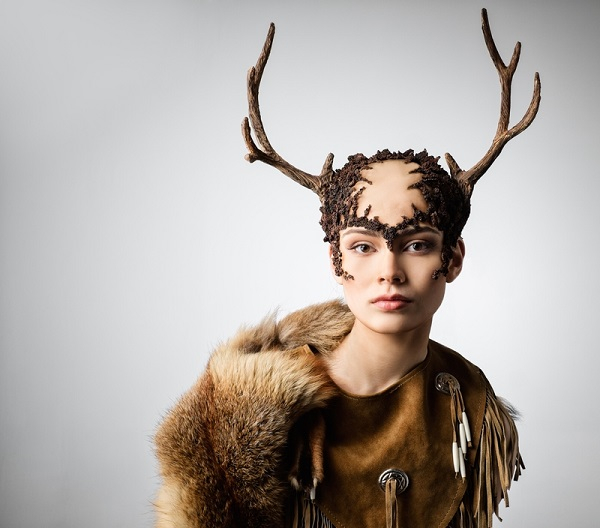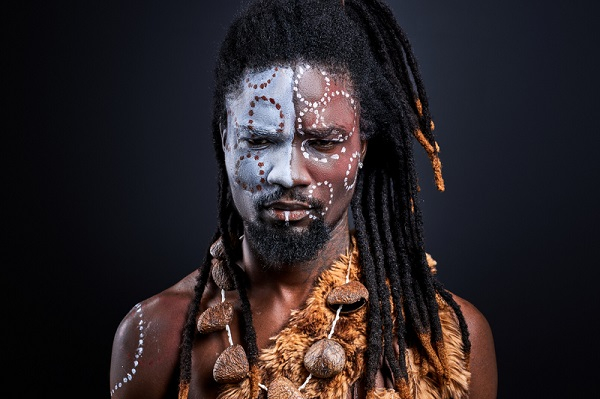

Shamanism is regarded as the world’s oldest religious practice originated among hunter-gatherer societies and persisted in some herding and farming societies. The word shamanism is derived from Manchu Tungus word šaman (Tungus religious practitioner) in which ša means to know, thus in literal meaning shaman is one who knows. Shamans form a personalistic relation with the spirit through ACS (altered state of consciousness) known as soul journey through which he derives power to heal the sick, communicate with spirits to benefit their community, influence spirits, and escort the dead to their final destination.

Figure 1: Woman shaman in a ritual dress with hawk
North Asiatic shamanism is considered the classical form of shamanism. It is distinguished by its rites, special clothing, and accessories. They have characteristic folklore and shaman songs and a specific worldview connected with them that the universe has many heavenly bodies inhabited by spiritual beings. The Earth is the central world which stands in water held at the back of gigantic creatures and connected to the Lower World through an umbilicus of sorts and the Upper World through the Pillar of the world.
It is believed that a person is chosen by supernatural beings to perform social roles. The belief of communication with spirits gives him authority in the community. He may perform beneficial as well as harmful activities which makes him feared. As a consequence, he is not allowed to participate in productive work, hunting or fishing so he is supported economically by the community. He is served the best and no one contradicts him even at the back. Such social and economic positions followed political power attainment by shamans, eg. Tungus shaman was also the clan's leader.
According to scholars, shamans obtain the profession by inheritance, instruction, or by vocation. Here, inheritance means the soul of a dead shaman is inherited, instructions are teachings by the spirits and vocation means the unavoidable call of the spirit who has chosen him and made him accept. They show the following characteristic
Mental characteristics such as intuition, sensitivity, eccentric personality along with some physical defect like extra toe or finger.
Believed to have active spirit and may have passive spirit of animal or person as guardian.
Use certain objects like gown, headgear, drum, drumsticks, metal rattler, staff and mirror during the trance act at will, mystical combat of two shamans in the form of animal or communicating with spirit.

Figure 2: Shaman tribal ritual man
A person can’t become a shaman simply by his will instead he is chosen by supernatural beings. It is believed, a shaman is born with an extra bone that differentiates him from ordinary people. The spirit causes some symptoms like falling repeatedly or having visions persistent for a few days or weeks. Lastly, in a dream or vision, supernatural beings appear to tell the intention. This calling is important to acquire the powers of shaman. During the initial stage, he may resist but torture in physical form or mental illness by the spirits breaks the resistance and he accepts by sleeping for long hours during which the spirit cuts him into pieces to check the possession of extra bone. If found, he becomes a shaman.
Shamans are classified into different groups of quality and degree of proficiency they possess. The qualitative category of least, intermediate, and great shamans is described by the type of spirit who chose them. It also depends on the kind of spirit they communicate such as White Shamans calling on benevolent deity/spirit while Black Shaman calls on malevolent deity/ spirit. According to Sakha people of northeastern Siberia, the future shamans’ souls are nurtured in nests on an immensely high tree in the Upper World. The greatest shamans are brought up close to the top of the tree, the intermediate ones toward the middle, and the lesser ones on the lower branches.
Shaman performs his duty through communication with the spirit either at will or through trance. There are two forms of trance
Trance of possession in which the shaman's body is possessed by a spirit and he enters into a high psychiatric state showing supernatural knowledge and power, he struggles and reaches a degree of senseless state. He gains consciousness after accepting the spirit and becomes its mouthpiece.
Active or wandering trance in which the shaman’s soul departs into the spiritual world and wanders to seek one of the world strata. He shares his wandering experience after awakening.
In some cases both combine, the spirit comes into the body first and guides the soul to the supernatural world
Shamanism can be traced among people who have been converted to other world religions through the analysis of former shamanic activities, folklores, and folk beliefs. However, shamanism was banished among the Kyrgyz and Kazakhs who became Islamic, and the eastern Buryat and Khalkha-Mongolian who adopted Buddhism, and was evolved into a divergent form by the Manchurians. It is also believed by scholars that shamanism extended to two American continents with migration of the first settlers of Asia.
Shamanism is a universal belief about spirits and spiritism emerged long ago in pre-historic times and continues to present times in various cultures of the world. It is a religious practice of hunter-gatherer culture, and forms the basis of many more formalised religions that retain shamanistic elements. This broader perspective is used by anthropologists to seek similarities among different traditions by linking them according to the social functions served by shamans.
Q1. What is animism?
Ans. Animism is a belief that all natural phenomena like humans, plants, animals, even rocks, mountains, rivers, etc. all possess a spiritual essence.
Q2. Give a general description of shaman dress.
Ans. A shaman wears regalia imitating an animal (mostly deer, bear, or a bird) which includes a headdress made of antlers or a band with pierced bird’s feather and symbolic footwear like bear paws, bird claws, or iron deer hooves.
Q3. What are the types of shamanic rituals?
Ans. There are two types of rituals: ua neeb sain which are diagnostic ceremonies and ua neeb khoe which are healing ceremonies.